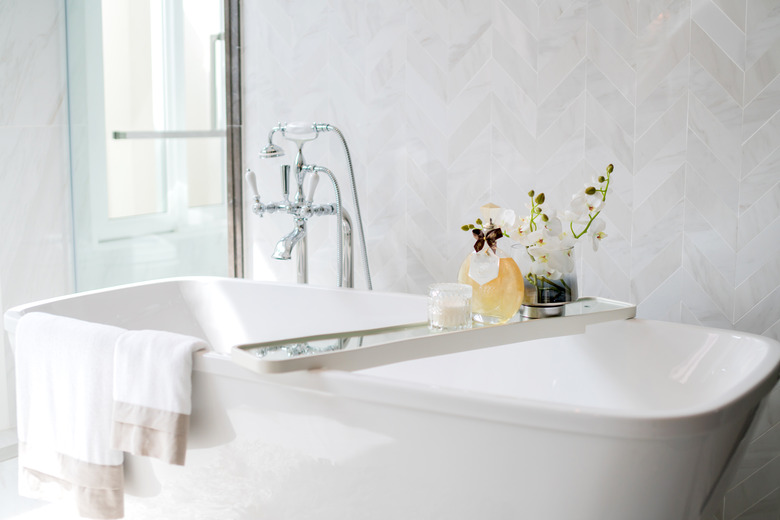How Do I Tell The Difference Between Fiberglass And Acrylic Tubs?
We may receive a commission on purchases made from links.
Bathtubs are made with many different materials, like fiberglass, acrylic, ceramic, porcelain, cast iron, cultured marble, stone resin, copper and even wood. When you are trying to tell the difference between fiberglass and acrylic tubs, know that the way they are manufactured is different, as is their weight. However, they have many similarities and are among the least expensive types of tubs. They are also somewhat porous, so they absorb more water compared to cast iron or stone resin.
Tip
The difference between fiberglass and acrylic tubs is not always obvious, but you may be able to tell by their weight, flexibility or color.
How Are These Tubs Made?
How Are These Tubs Made?
Fiberglass is made from small strings of glass that are woven together to create one solid material. This is then made into layers, molded into the shape of a bathtub and coated with gelcoat resin.
Acrylic is made from resins, petrochemicals, stabilizers, fillers and dye. It comes in solid sheets, which are melted down and molded into bathtub shapes. These are then finished with fiberglass for reinforcement.
Both use lightweight materials and are budget-friendly, durable and easy to install and maintain. They should last about 10 years. Acrylic and fiberglass have glossy finishes that are pleasing to the eye, but acrylic may be a bit more expensive.
Do These Tubs Look Different?
Do These Tubs Look Different?
Fiberglass and acrylic surfaces can look similar, but fiberglass tubs are usually thicker than their acrylic counterparts. Look around the tub's edges and see if it appears thinner; this could be an indication that it is acrylic. Acrylic tubs usually come in more colors than fiberglass tubs, as fiberglass tubs are commonly white. Acrylic also feels warmer to the touch than fiberglass, and tubs made of acrylic have smoother finishes.
Acrylic tubs weigh more than fiberglass ones. If the tub is freestanding and acrylic, it will weigh about 100 pounds on average. Fiberglass tubs are lighter, averaging around 70 pounds. The latter can also feel flimsier and may be flexible if pushed.
Today's fiberglass and acrylic tubs look sleek and modern and are sold in different shapes, styles and price ranges. Some are freestanding with flat bottoms or are claw-footed, with the tub-filling apparatus included in the purchase.
Pros and Cons of Each
Pros and Cons of Each
Once a fiberglass tub's protective coating starts to wear off, the porous fiberglass underneath may become exposed. This can cause the tub to warp. Acrylic tubs do not damage as easily as fiberglass since they better handle impact and weight.
Both tubs are more convenient for second-story installations since they do not need the same kind of reinforcement underneath that is required for heavier tubs. The initial cost for fiberglass tubs is less than acrylic tubs. Shower Plus Bath says they average $300 to $500, while acrylics average $500 to $1,200. However, fiberglass tubs are easier to repair than acrylic tubs.
Keeping Your Bathtub Clean
Keeping Your Bathtub Clean
When it comes to ease of cleaning and maintenance, acrylic tubs come out ahead. They resist chips and scratches better than fiberglass, and they can be cleaned with soapy water, vinegar and other abrasive cleaning agents marketed for tub cleaning. Do not use scouring pads or steel wool, though; a soft-bristled brush works best.
Be more careful when cleaning a fiberglass tub since abrasive cleaners and cleaning tools can scratch them. They can be cleaned with distilled white vinegar, baking soda and a wet sponge.
